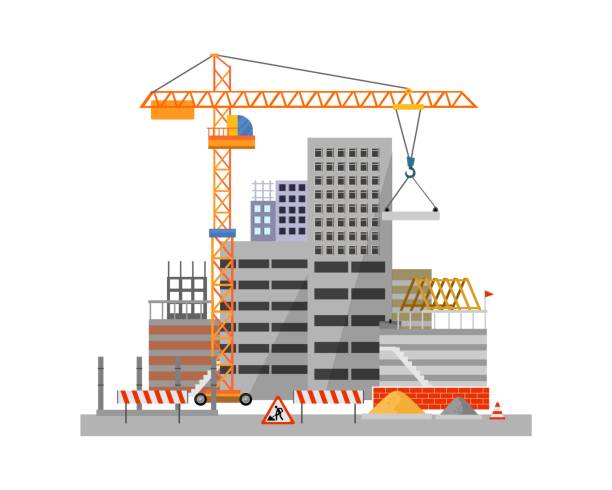Let's build A Legacy together.
We want to build your dream home.

Welcome to Statelordgroup constructions, a fresh approach to construction where creativity, technology, and craftsmanship converge. As a new player in the industry, we bring a dynamic perspective and a passion for redefining what's possible in construction.
The solution to all your residential needs with creative ideas proper planning and execution is key to delivering the best to our customers.
Our company was founded with a vision to achieve leadership in the field of civil construction and to provide our best services to the satisfaction of all our clients.
At Statelordgroup constructions , we believe in more than just erecting structures; we believe in shaping environments that inspire. With a team of forward-thinking professionals, we are dedicated to revolutionizing the way construction projects come to life.
Construction types vary widely depending on the purpose, scale, and materials used. Here are the main types of construction:
Involves building homes, apartments, townhouses, and other housing structures. Often smaller scale but can include complex customizations and interior designs. Common materials include wood, concrete, steel, and bricks.
Includes buildings such as shopping malls, office buildings, warehouses, and retail stores. Emphasis is placed on functionality, aesthetics, and meeting specific business needs. Typically involves larger budgets and more complex infrastructure compared to residential.
Involves the construction of factories, power plants, refineries, and other facilities. Requires specialized knowledge and materials to accommodate heavy machinery, large-scale production, and safety regulations. Focuses on durability and functionality, with steel and concrete being common materials.
This type includes the construction of highways, bridges, tunnels, railways, and airports. Often publicly funded and involves large-scale earthmoving and specialized engineering. Requires strong and durable materials like concrete, steel, and asphalt.
Includes schools, hospitals, government buildings, and other community facilities. Emphasizes functionality, safety, and accessibility. These projects may also include specific requirements for durability and safety in public access spaces.
Focuses on projects that improve or protect the environment, such as water treatment plants, waste management facilities, and flood protection. Involves both construction and engineering efforts to create sustainable solutions.
Encompasses any unique projects like dams, museums, stadiums, or historical renovations. Often involves unique architectural features, specialized materials, and requires high-level expertise.
Involves building sections (modules) offsite and assembling them onsite. Growing in popularity due to faster construction times, reduced labor costs, and minimal site disturbance. Commonly used in residential and commercial projects, especially in remote areas or areas needing quick build times. Each type comes with its own set of challenges, materials, and skill requirements, catering to the specific demands of different projects.
Known for its charming, rustic look with stone or brick exteriors, steep thatched roofs, and small, cozy rooms. Often features small, flower-filled gardens and wooden beams.
Typically found along coastlines, designed for relaxation with open layouts, large windows, and light, airy decor. Often painted in soft pastel or nautical colors and includes wraparound porches or decks.
Built from logs, giving a rustic, cabin-like aesthetic, often found in rural or mountainous areas. Known for their natural, earthy feel, emphasizing wood materials inside and out.
Designed to blend into mountainous environments with sturdy structures, often made from stone and wood. Features large fireplaces, cozy interiors, and steep roofs to handle heavy snowfall.
Mixes traditional cottage elements with contemporary designs, often including open floor plans and modern materials. Often incorporates large windows, metal fixtures, and minimalist decor while keeping a cozy feel.
Originating from New England, these have steeply pitched roofs, central chimneys, and symmetrical facades. Simple and practical, with a cozy, traditional interior, often featuring shingle siding.
A blend of farmhouse and cottage styles, these homes often have large porches, open kitchens, and rustic decor. Interiors are comfortable and practical, often featuring wood and antique furnishings.
Typically found near lakes, with designs maximizing water views and outdoor access. Often has decks or patios, boathouses, and open interiors to create a seamless indoor-outdoor experience.
Built from a single shipping container, usually 20 or 40 feet long. Compact and efficient, typically used for tiny homes or small office spaces. Minimalistic design with basic amenities and often open-plan interiors.
Combines several containers, stacked or joined side-by-side, to create larger living spaces. Allows for multiple rooms, larger kitchens, and even multi-level designs. Offers flexibility in layout and can be highly customized.
Incorporates high-end finishes and custom designs, such as rooftop terraces, large windows, and modern interiors. Often combines containers with other materials like wood, steel, or glass for an upscale aesthetic. Designed to rival traditional luxury homes in both function and style.
Designed for sustainability with features like solar panels, rainwater collection, and composting toilets. Often compact and self-sufficient, making it ideal for remote locations. Uses sustainable materials and focuses on energy efficiency.
Containers repurposed into workspaces, studios, or offices, sometimes stacked or joined to create unique layouts. Typically open-plan and customized with necessary office amenities. Allows for mobility and easy relocation if needed.
Container homes built to be easily moved from one location to another, often used as temporary housing or for travel. Compact and functional, with foldable furniture and simple interiors. Often smaller and more self-contained, with minimalistic but practical designs
Features expandable walls or sections that can increase the interior space when parked. Designed for flexibility and often used as temporary housing, vacation homes, or remote office spaces. Combines portability with a more spacious feel when expanded.
Integrates a green or living roof to promote insulation, biodiversity, and environmental sustainability. Adds a unique visual element and helps reduce energy consumption. Often paired with eco-friendly features and materials for an environmentally conscious lifestyle.
Focus on updating the look and feel of a space without major structural changes. Includes painting, new flooring, lighting updates, and replacing fixtures. Often the quickest and most cost-effective way to refresh a property.
Involve changes to the structure, such as removing or adding walls, strengthening foundations, or extending rooms. Common in older homes or when changing the layout. Requires professional assessment to ensure safety and compliance with building codes.
Involves updating cabinets, countertops, appliances, and layouts to improve functionality and aesthetics. Often includes plumbing and electrical work for new appliances. A popular choice for adding value to a home and enhancing the main gathering area.
Focus on updating fixtures, tiles, lighting, and sometimes the layout to improve functionality and comfort. May involve upgrading plumbing, ventilation, and waterproofing. Helps improve the property’s appeal, as bathrooms are a major focus for buyers and renters.
Transform an unfinished basement into a functional living area, such as a family room, guest suite, or home office. Often requires moisture control, insulation, and possibly adding windows or exits for safety. Can add significant usable space and value to a home.
Converts unused attic space into a bedroom, office, or storage area.Typically requires insulation, ventilation, and sometimes dormer windows to increase headroom. Can provide additional living space without expanding the building's footprint.
Enhances curb appeal and the property’s exterior with changes like new siding, roofing, windows, doors, and landscaping. May include updating decks, patios, or driveways. Improves the first impression and protects the structure from weather elements.
Focuses on improving energy efficiency through insulation, solar panels, energy-efficient windows, and LED lighting. Often includes upgrading HVAC systems and installing smart thermostats. Helps reduce energy bills and is increasingly popular for environmental and cost-saving reasons.
Adds square footage by expanding the property with new rooms, such as an additional bedroom, bathroom, or a sunroom. Requires significant planning and structural work, including permits and foundation work. Adds value and functionality, especially for growing families.
Modifies spaces to make them more accessible for individuals with disabilities or mobility issues. Includes ramps, wider doorways, grab bars, and accessible showers or toilets. Important for aging in place or making spaces inclusive for all residents.
Restores a historic property to its original appearance or adapts it while preserving key architectural features. Requires specialized materials and methods to maintain historical accuracy.Often regulated by local preservation laws, requiring adherence to specific guidelines.
Tailored to business spaces like offices, restaurants, or retail stores, focusing on functionality and brand aesthetics. May involve layout changes, updated lighting, and creating flexible workspaces. Enhances customer appeal and employee productivity.
Involves renovating the entire property, often including multiple rooms and structural changes. Can include everything from new layouts to updated fixtures and finishes throughout. Significant investment but results in a complete transformation of the space.
Meet with All Our Qualified Team Members
Founder/Director
Co-Founder
Sales Head - Local
Sales Head - Overseas
Key Account Manager
Documentation & Accounting Specialist
See All Our Updated and Latest News
Our Happy Clients Tell About Us
Ancillae interpretaris ea has. Id amet impedit qui, eripuit mnesarchum percipitur in eam. Ne sit habeo inimicus, no his liber regione volutpat. Ex quot voluptaria usu, dolor vivendo docendi nec ea. Et atqui vocent integre vim, quod cibo recusabo ei usu, s
Ancillae interpretaris ea has. Id amet impedit qui, eripuit mnesarchum percipitur in eam. Ne sit habeo inimicus, no his liber regione volutpat. Ex quot voluptaria usu, dolor vivendo docendi nec ea. Et atqui vocent integre vim, quod cibo recusabo ei usu, s
Ancillae interpretaris ea has. Id amet impedit qui, eripuit mnesarchum percipitur in eam. Ne sit habeo inimicus, no his liber regione volutpat. Ex quot voluptaria usu, dolor vivendo docendi nec ea. Et atqui vocent integre vim, quod cibo recusabo ei usu, s
All Our Company Partners are Listed Below







Ancillae interpretaris ea has. Id amet impedit qui, eripuit mnesarchum percipitur in eam. Ne sit habeo inimicus, no his liber regione volutpat. Ex quot voluptaria usu, dolor vivendo docendi nec ea. Et atqui vocent integre vim, quod cibo recusabo ei usu, s